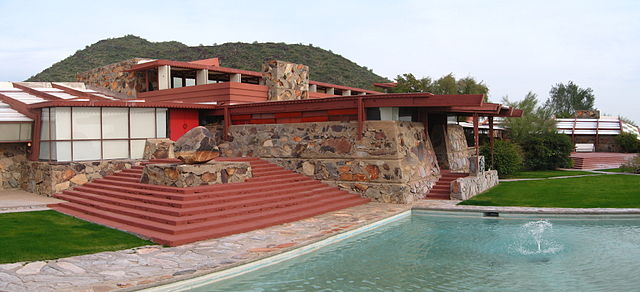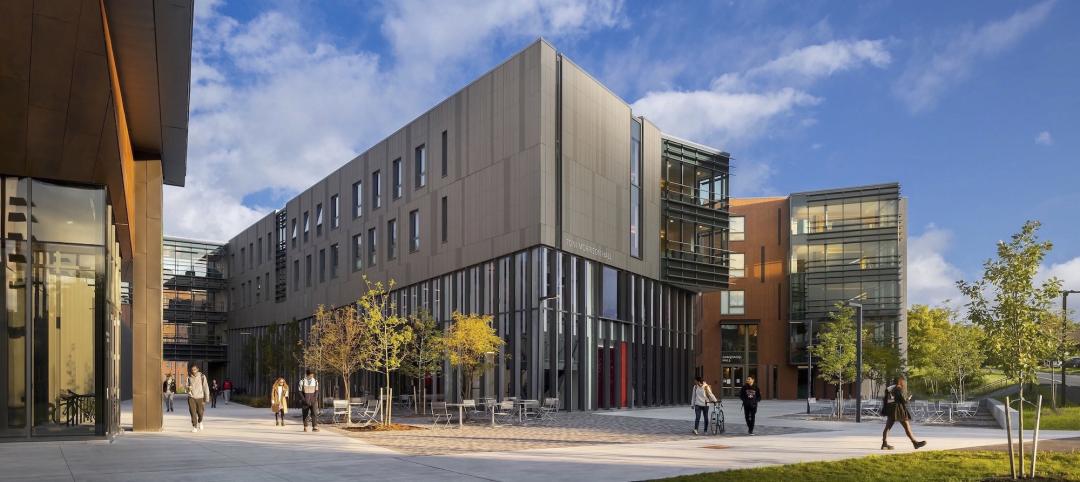The Frank Lloyd Wright Foundation announced today that, at its Dec. 5 Board meeting, it approved a possible path towards independent incorporation of the Frank Lloyd Wright School of Architecture. The Foundation Board’s decision has been embraced and approved by the School of Architecture Board of Governors and representatives of alumni and the broader school community.
In order to meet critical fundraising goals that will allow it to achieve the financial autonomy necessary to become an independent organization, the Frank Lloyd Wright School of Architecture is immediately launching the Campaign for Independence – to raise $2 million before the end of 2015.
Providing one of the most notable educational experiences in the country, the School’s professional M.Arch degree program offers graduate students hands-on, design-intensive studio experiences within the immersive educational communities of Taliesin West (Scottsdale, Arizona) and Taliesin (Spring Green, Wisconsin). This past year saw the highest number of new students in the School’s history, 100% student retention for the third consecutive year, and the launch a “Teaching Fellowship” program that has added five distinguished international architectural educators and practitioners to the School’s teaching ranks.
Despite its recent successes, as was previously reported, accreditation for the School is threatened because the Higher Learning Commission (HLC) changed its by-laws, resulting in an expectation that the Foundation retain ultimate financial responsibility for the School while simultaneously ceding governance, financial, and operational control to a separate, autonomous organization. After two years of exploration and debate, the Foundation Board concluded that it could not agree to guarantee funding to an autonomous School to the level it would need to thrive without retaining ultimate control or decision-making authority, particularly given its responsibility to find funding for tens of millions of dollars (at least) in critically needed preservation work in the coming years and for the other critical components of the Foundation’s mission.
Following that determination, longtime supporters of the School suggested the possibility of raising substantial funds to create and support an independent School. The Foundation Board readily agreed that, if the School community can raise funds sufficient to demonstrate that the new organization would have “its own financial resources” (as explicitly required by the HLC’s by-laws) then spinning off the School would not present the same obstacles. The new, independent school organization would take ultimate fiduciary responsibility for itself.
As part of the new structure, the Foundation would donate over $1 million in facilities-related cash expenses every year, related to the School’s extensive use of Taliesin West and Taliesin as its campuses (at no cost to the School). The Foundation would also contribute an additional subsidy of $580,000 to the School in 2015, with decreasing levels of such additional transitional support over the next five years (but always continuing to cover 100% of annual facility-related expenses of well over $1 million).
“If the School community can successfully raise this $2 million,” said Jeffrey Grip, Chair of the Foundation Board of Trustees the Foundation, “the Foundation will proudly and enthusiastically commit to independently raising funds to match that giving 3.5 to 1, with support of more than $7 million over the next five years.”
In order to achieve the desired independence and continue as a stand-alone School of Architecture, gifts and pledges for an initial $1 million in contributions must be received by March 27, 2015 – and gifts/pledges for a second million must be received by Dec. 31, 2015.
“There is an exceptionally bright future possible for the Frank Lloyd Wright School of Architecture,” said Maura Grogan, Chair of the School’s Board of Governors. “But that future is only possible with the generous support of donors, right now. Without significant and immediate support, there will no longer be a stand-alone accredited Frank Lloyd Wright School of Architecture. This campaign is the only opportunity to save the Frank Lloyd Wright School of Architecture as we know it – and to ensure its success and impact for decades to come. I urge people to join us in this critical endeavor.”
Related Stories
Green | Dec 9, 2022
Reaching carbon neutrality in building portfolios ranks high for organizations
Reaching carbon neutrality with their building portfolios ranks high in importance among sustainability goals for organizations responding to a Honeywell/Reuters survey of senior executives at 187 large, multinational corporations. Nearly nine in 10 respondents (87%) say that achieving carbon neutrality in their building portfolio is either extremely (58%) or somewhat (29%) important in relation to their overall ESG goals. Only 4% of respondents called it unimportant.
Green | Dec 9, 2022
Newly formed Net Zero Built Environment Council aims to decarbonize the built world
Global management consulting firm McKinsey recently launched the Net Zero Built Environment Council, a cross-sector coalition of industry stakeholders aiming to decarbonize the built world. The council’s chief goal is to collaboratively create new pathways to cut greenhouse gas emissions from buildings.
High-rise Construction | Dec 7, 2022
SOM reveals its design for Singapore’s tallest skyscraper
Skidmore, Owings & Merrill (SOM) has revealed its design for 8 Shenton Way—a mixed-use tower that will stand 63 stories and 305 meters (1,000 feet) high, becoming Singapore’s tallest skyscraper. The design team also plans to make the building one of Asia’s most sustainable skyscrapers. The tower incorporates post-pandemic design features.
Office Buildings | Dec 7, 2022
Software giant SAP opens engineering academy for its global engineering workforce
Software giant SAP has opened its new SAP Academy for Engineering on the company’s San Ramon, Calif. campus. Designed by HGA, the Engineering Academy will provide professional development opportunities for SAP’s global engineering workforce. At the Engineering Academy, cohorts from SAP offices across the globe will come together for intensive, six-month training programs.
Multifamily Housing | Dec 7, 2022
Canada’s largest net-zero carbon residential community to include affordable units
The newly unveiled design for Canada’s largest net-zero carbon residential community includes two towers that will create a new destination within Ottawa and form a striking gateway into LeBreton Flats. The development will be transit-oriented, mixed-income, mixed-use, and include unprecedented sustainability targets. Dream LeBreton is a partnership between real estate companies Dream Asset Management, Dream Impact, and local non-profit MultiFaith Housing Initiative.
Student Housing | Dec 7, 2022
Cornell University builds massive student housing complex to accommodate planned enrollment growth
In Ithaca, N.Y., Cornell University has completed its North Campus Residential Expansion (NCRE) project. Designed by ikon.5 architects, the 776,000-sf project provides 1,200 beds for first-year students and 800 beds for sophomore students. The NCRE project aimed to accommodate the university’s planned growth in student enrollment while meeting its green infrastructure standards. Cornell University plans to achieve carbon neutrality by 2035.
Office Buildings | Dec 6, 2022
‘Chicago’s healthiest office tower’ achieves LEED Gold, WELL Platinum, and WiredScore Platinum
Goettsch Partners (GP) recently completed 320 South Canal, billed as “Chicago’s healthiest office tower,” according to the architecture firm. Located across the street from Chicago Union Station and close to major expressways, the 51-story tower totals 1,740,000 sf. It includes a conference center, fitness center, restaurant, to-go market, branch bank, and a cocktail lounge in an adjacent structure, as well as parking for 324 cars/electric vehicles and 114 bicycles.
Multifamily Housing | Dec 6, 2022
Austin's new 80-story multifamily tower will be the tallest building in Texas
Recently announced plans for Wilson Tower, a high-rise multifamily building in downtown Austin, Texas, indicate that it will be the state’s tallest building when completed. The 80-floor structure will rise 1,035 feet in height at 410 East 5th Street, close to the 6th Street Entertainment District, Austin Convention Center, and a new downtown light rail station.
Geothermal Technology | Dec 6, 2022
Google spinoff uses pay-as-you-go business model to spur growth in geothermal systems
Dandelion Energy is turning to a pay-as-you-go plan similar to rooftop solar panel leasing to help property owners afford geothermal heat pump systems.
Contractors | Dec 6, 2022
Slow payments cost the construction industry $208 billion in 2022
The cost of floating payments for wages and invoices represents $208 billion in excess cost to the construction industry, a 53% increase from 2021, according to a survey by Rabbet, a provider of construction finance software.

















